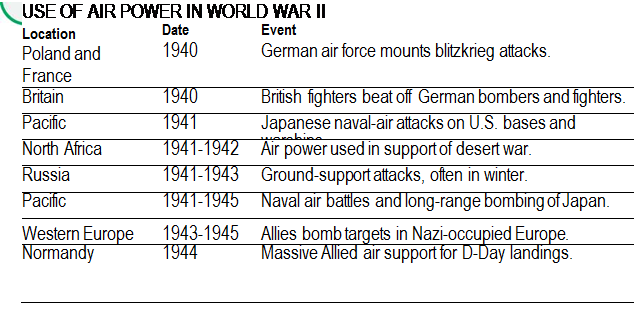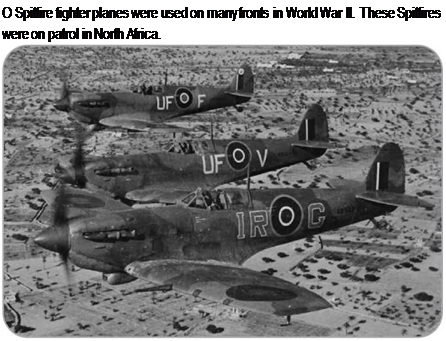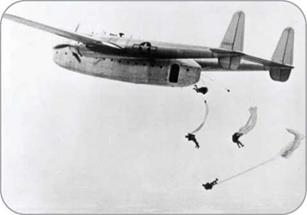World War II
World War II (1939-1945) was the first major war in which aircraft played a decisive part. Hardly any of the battles, on land or sea, were fought without airplanes. During the war, the speed and offensive power of warplanes increased dramatically.
Warplanes of World War II included fighters, fighter-bombers, bombers, trainers, transports, seaplanes, and a variety of specialized and general aircraft, including the first helicopters. Aircraft supported armies on the ground, dropped bombs on cities, and patrolled the oceans to attack ships and submarines. Planes dropped paratroopers, carried soldiers and supplies into combat zones, evacuated the wounded, and made reconnaissance flights.
|
|
|
О Paratroopers jump from a transport plane during World War II. The war saw the first extensive use of paratroops and other advances in aviation. |
Air Forces
 |
When war began in Europe in September 1939, the strongest air forces in Europe were Germany’s Luftwaffe and Britain’s Royal Air Force (RAF). The United States as yet had no separate air force-its
 warplanes were flown by the U. S. Army, U. S. Navy, and U. S. Marine Corps.
warplanes were flown by the U. S. Army, U. S. Navy, and U. S. Marine Corps.
New ideas about the use of air power had been put forward in the 1920s by Italy’s Giulio Douhet (1869-1930), who predicted that the bomber would be the key weapon in a future war. Similar ideas were advanced by Billy Mitchell (1879-1936), an advocate of an independent air force for the United States. British air force commanders, such as Hugh Trenchard (1873-1956), supported these ideas.
The Germans tested some new ideas by sending pilots and planes to fight in the Spanish Civil War (1936-1939). The German Luftwaffe was equipped with around 5,000 planes, mostly medium bombers, dive bombers, fighters, and troop transports. The Luftwaffe was intended to support fast-moving armor and infantry on the ground. This blitzkrieg (lightning war) strategy worked well during the German invasions of Poland (1939) and of Belgium, Holland, and France (1940).
The Germans enjoyed air superiority during these invasions. Poland’s air force was out-of-date, and there were only a few modern French fighters, such as the Dewoitine D.520, to match those of the Germans. Britain sent planes to aid France but found that its airplanes
(such as the Battle light bomber), were ineffective and were soon shot down. With the fall of France to the Germans, British fighter commander Hugh Dowding gathered his squadrons for the next battle.











